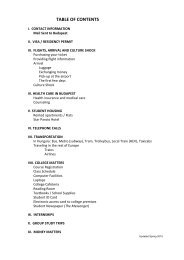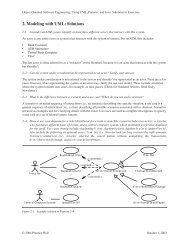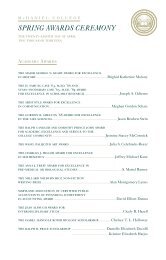You also want an ePaper? Increase the reach of your titles
YUMPU automatically turns print PDFs into web optimized ePapers that Google loves.
Pathologies of Communicationby Luther F. Sies, '48In an age sufficiently introspective to identify itselfas the Age of Anxiety, innumerable sources of tensionsand frustrations continually appear. One major sourceof current concern 'is the problem of communication.These problems will be discussed here as pathologies ofcommunication.What image am I communicating? Am I telling them?Am 1 really happy? The first question might as readilybe asked by a teen-ager, college professor, or corporationexecutive; the second, by those egocentric personswho usually also mean the unexpressed what I want totell them; the third, by unfortunate persons of variedages and social stations. Each questioner in his uniqueway, to be sure, is concerned about communication. Thefirst two questioners may themselves possess communicativedisorders. It is almost certain that the last one does.In order to analyze and diagnose communicative pathologies,the works of such diverse authorities as psychologistCarl Rogers and semanticist Alfred Korzybski arecertainly required reading.Gradually the general belief spread through our societythat a serious crisis in communication existed. Onemanifestation of the concern was a wave of criticismthat high school graduates were unable to speak andwrite correctly. Loud criticisms of public education ingeneral soon followed. Johnny can't read, they charged,and neither can he speak or write. Unfortunately, thiswas true for far too many children, but the publicschools alone were not to blame. Pathologies of communicationcertainly do not result solely from what happens-or,does not happen-in the public schools. Atany rate, however, the statistics present a grim picture,indeed, with respect to the communication skills of manyAmerican citizens. Consider illiteracy as one example, forthis is one aspect of communicative pathology that canbe clearly identified and discussed.Illiteracy is defined as the inability to read and write.According to the United Nations' Statistical Yearbook,approximately 44 percent of the world's population beyondthe age of fifteen are illiterate. The StatisticalAbstract of the United States issued by the Bureau ofthe Census in 1965 states that 2.2 percent-or, 2,619,000-Americans beyond the age of fourteen are illiterate.All of us should be seriously concerned about both setsof data, and this is exactly the concern that has beenvoiced by Dean Frances Chase. Dean Chase has written."The values of our civilization are more endangered byilliteracy than by any nuclear 'bomb. Two forms of illiteracyare the inability to receive and express ideasthrough reading and writing; and the higher illiteracyor inability to relate the content of verbal communicationto events which at each moment are shaping thefuture." In order to handle the symbols of our massmedia, for example, we must achieve the highest literacyor run the risk of harvesting the emotional stresses andstrains experienced by those whom Riesman has calledouter-directed men.The higher illiteracy, as identified by Chase, warrantsinclusion as a pathology of communication. This group'sbehavior is roughly analogous to that which Hulseidentified as the illiteracy of the literate. In their ownway, these individuals pose far greater dangers to thecommon good than the culturally deprived children fromthe urban slums-or the Appalachian mountains-whocannot read at all.Communication pathologies may take such variedforms as articulatory disorders, voice problems, aphasiclanguage disorders, stuttering, cluttering, cleft palatespeech, cerebral palsied speech, and hearing impairments.In the primary grades of the elementary schools,for example, the incidence of speech and language disordersis approximately 8 percent. Organically causedhearing impairments that are educationally significant inthe same population would be found for approximately5 percent of the children. Some overlapping of thesetwo populations undoubtedly will occur, but the numberof children with some form of communicative pathologywill probably reach 10 percent of the total population.As these children mature, these percentages will decreaseonly if some successful therapeutic programshave been instituted. Hearing impairments, on the otherhand, will show a sharp increase as the group ages,and the process of aging and the ravages of disease taketheir toll. Finally, after middle age many individuals willincur such organically caused speech and language disordersas aphasia, a disorder of the symbolization processcaused by the brain-injury often associated with stroke'and laryngectomy, toe surgical removal of the larynx t~treat cancer of that vocal mechanism. In summary, then,OUT population as it ages presents the following typicalpattern of communication pathologies: As children-ofsay, ten or eleven years of age-approximately 10 percentwill present disorders of speech and hearing. Fromadolescence through early middle age, approximately8 percent of the population will exhibit various communicativedisorders. In late middle age and during thepage five

















